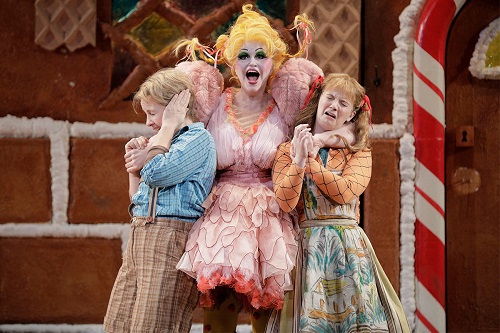 United States Humperdinck, Hansel and Gretel: Soloists, Chorus and Orchestra of LA Opera / James Conlon (conductor), Members of Los Angeles Children’s Chorus, Dorothy Chandler Pavilion, Los Angeles, 17.11.2018. (JRo)
United States Humperdinck, Hansel and Gretel: Soloists, Chorus and Orchestra of LA Opera / James Conlon (conductor), Members of Los Angeles Children’s Chorus, Dorothy Chandler Pavilion, Los Angeles, 17.11.2018. (JRo)

© Cory Weaver
Cast:
Hansel – Sasha Cooke
Gretel – Liv Redpath
The Witch – Susan Graham
Mother (Gertrude) – Melody Moore
Father (Peter) – Craig Colclough
Sandman – Taylor Raven
Dew Fairy – Sarah Vautour
Production:
Director – Doug Fitch
Scenery and Costumes – Doug Fitch
Lighting – Duane Schuler
Movement – Austin Spangler
Hansel and Gretel is a holiday plum – you could call it The Nutcracker of opera – and this production delights on two counts, with music sophisticated enough for the most demanding opera fan and a beloved story to enrapture children.
In the hands of James Conlon and the LAO Orchestra, the music was pure poetry: Wagnerian sweep seasoned with the simplicity of folk song. The silvery evocation of forest life, the tenderness of the Evening Prayer and the rollicking Witch’s Ride materialized seamlessly from the pit.
The ensemble of singers inhabited their roles with gusto, from the newest addition to the Domingo Young Artist Program, Sarah Vautour, to the most seasoned in the cast, Susan Graham. Always a standout with her buttery soprano, Liv Redpath was every inch the child Gretel, romping with the loose-limbed vigor of a ten-year-old, while Sasha Cooke with her robust mezzo was a believable, headstrong Hansel.
Graham relished the witch’s role, embracing the Pippi Longstocking wig, pink tutu and platform shoes that Doug Fitch created for the original 2006 LA Opera production. It’s not my favorite visual incarnation of the Witch, but it was certainly colorful enough to hold the attention of the many children at this opening performance.
In a translation by Richard Sparks, the libretto had ingenious moments and secularized the religious aspects of the text, but at times the rhyming was forced and devoid of childlike glee. How does one improve on the Witch’s ‘Nibble, nibble mousey, who’s nibbling at my housey?’ of Norman Kelley’s translation? Not with Sparks’s take, which went roughly like this: ‘Oh so sweet and crumbly, won’t you join my fambly?’
Craig Colclough and Melody Moore gave deeply satisfying performances as Peter and Gertrude. Even amid the hunger and deprivation faced by the family, they added the right touch of humor in their interactions. A string of sausages materialized out of Peter’s pocket and was then worn as a necklace by Gertrude which had the audience roaring with laughter. Colclough’s lyricism coupled with his warm, rounded tones added depth and focus to a score written mainly for female voices, and Moore matched his intensity with her vibrant soprano.
Some costume decisions felt off the mark – mezzo Taylor Raven was delightful as the Sandman, but decked out in a Liberace-style gold tuxedo, she seemed out of place in a forest glade. This led me to ponder Fitch’s decision to perch the Dew Fairy on an enormous tower of a skirt sprinkled with stars and wearing a wig resembling a five-pointed star – more Queen of the Night on high than nimble forest sprite.
The sets and costumes in Act I had the feel of a children’s picture book come to life and struck the right note of fantasy and familiarity. In an inspired touch, the wood and straw furniture in the family’s cottage swayed to Hansel and Gretel’s dance duet, then frolicked and spun alongside the children. When Gertrude arrived home to find the children shirking their chores, her angry face was projected gigantically in a live video feed outside the windows. A little bit of that would have been enough to make the point, but it continued for so long that I found myself wondering if she would ever come inside the house.
The set of Act Two, more abstract in nature as befits a more fantastic act, had its charms, especially for the younger audience. Replacing angels, Sesame Street-like characters with illuminated eyes appeared in the forest and watched over Hansel and Gretel. They were colorful enough to appeal to the smallest child in the house, but I would have preferred to see some resemblance to real forest animals.
Because of the creatures’ bulky costumes, movement director Austin Spangler faced serious limitations. The animals, for the most part, rambled aimlessly in circles or lumbered slowly backwards and forwards. Director Fitch would have been better off adding more mystery to their entrances and exits by delaying their arrival until the last moment or having them disappear into the shadows.
The gingerbread cookies, which famously have children baked inside, were dry and forbidding – no frosting decorated their surfaces to beguile. When the cookies dropped away following the healing touch of Hansel and Gretel, members of the LA Children’s Chorus swarmed about their saviors in a chorus of thanks. As all are finally reunited with Peter and Gertrude, the joy was both contagious and uplifting – just the right start for the holiday season.
Jane Rosenberg